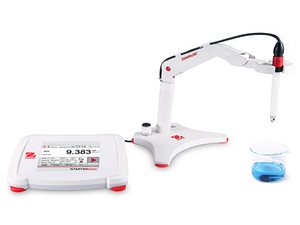-(2).jpg)
1. How often does the pH electrode need to be calibrated?
The frequency of electrode calibration is dependent on the precision requirement, sample temperature, surrounding environment and process arrangement of sample test (for example, interference ingredient, flushing and storage, etc.).
In order to ensure the accuracy of measurement results, we recommend you calibrate it frequently, preferably one calibration or verification every 10 measurements. If the sample has a complex composition or the electrode is used frequently, you should increase the frequency of calibration.
Use two groups of buffer solutions approximating the measurement value. Please calibrate the buffer solution of pH 7.00 first.
When the electrode reading drifts or the slope is lower than 95%, you should clean the electrode.
2. Should a single point, two points or multiple points be used for calibration?
Single-point calibration can be used for routine measurements. We recommend you use the two-point calibration when a precise measurement is needed.
The following global standards can be used as a reference:
ASTM 1293-12 Standard Test Methods for pH of water by the American Society Testing and Materials is suitable for the aqueous solutions with a conductivity ≥5 μS/cm. It is specified to use a minimum of two-point calibration for measurement and the agitation should be performed during the measurement.
ASTM E70-2015 Standard Test Methods for pH of water by the American Society Testing and Materials is suitable for measuring the pH value of the aqueous solutions with a pH 2~12 and total ion strength lower than 0.1 mo1/L and specifies that a two-point calibration should be adopted for the measurement.
GB 6920-86 water quality―Determination of pH value―Glass electrode value―Glass electrode by Ministry of Ecology and Environment of the People's Republic of China is suitable for potable water, ground water and industrial waste water. It is recommended that you adopt a two-point calibration method.
3. What do I do if the calibration slope is higher than 105%?
- Check the buffer solution’s expiry or whether it has been polluted. If it expired, use a new buffer solution.
- Check whether you have selected the correct buffer solution.
- The buffer solution group is set wrong. Select the correct buffer solution group as per the buffer solution used.
4. Why does the result of pH measurement fluctuate for a long time?
Generally, it requires 1-4 minutes for the reading of a pH measurement to be stable. If it exceeds a reasonable time, please refer to the following:
a) The selected pH electrode cannot handle the present sample. Because different samples have unique properties that influence the measurement of pH
- It takes a long time (one measurement takes longer than 10 minutes)
- Measurement precision is poor (the sample contains particles resulting in the electrode’s liquid junction becoming blocked and the high-salt sample penetrates into the pH electrode to result in a polluted electrode).
b) Electrode is aged: This can result in a slowed reaction rate/ decreased slope/zero-potential drift. If the response time exceeds 1 minute when the electrode is placed in a newly-prepared buffer solution, you needs to activate the electrode or change for a new electrode.
Unlike pH measurement with a pH test paper, the pH meter is a whole measurement loop set including instrument, electrode and sample. Only the correct combination of all three can realize a precise pH test. Any issues with any of these three will create an error in the measurement system.
That’s why you need high quality laboratory-specialist pH equipment along with these tips for accurate measurements. Check out the
OHAUS Starter 5000 pH Bench Meter.

- IP54 waterproof and dustproof instrument
- Measurement precision of 0.1pH-0.001pH & 1mV-0.01mV
- Allows 1-9 point calibration
- Storage of 1000 measurement data
- 10 electrodes & storage of 10 sets of calibration data
- Compatible with 8 buffer solutions
- Automatic temperature correction
- Standard configuration with RS232 interface and USB, convenient for data export and printing
- Independent electrode support offering operator flexibility
- 4.3 in. color touch screen offers simple and convenient operation